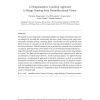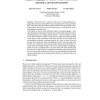184 search results - page 23 / 37 » Learning Expressive Models for Word Sense Disambiguation |
RAS
2010
13 years 6 months ago
2010
We present a novel approach to estimating depth from single omnidirectional camera images by learning the relationship between visual features and range measurements available dur...
TASLP
2010
13 years 2 months ago
2010
To solve the knowledge bottleneck problem, active learning has been widely used for its ability to automatically select the most informative unlabeled examples for human annotation...
ACL
2010
13 years 5 months ago
2010
The pipeline of most Phrase-Based Statistical Machine Translation (PB-SMT) systems starts from automatically word aligned parallel corpus. But word appears to be too fine-grained ...
NLPRS
2001
Springer
14 years 3 days ago
2001
Springer
Named Entity recognition, as a task of providing important semantic information, is a critical first step in Information Extraction and QuestionAnswering system. This paper propos...
ICALP
2007
Springer
14 years 1 months ago
2007
Springer
Abstract. Nested words are a restriction of the class of visibly pushdown languages that provide a natural model of runs of programs with recursive procedure calls. The usual conne...


